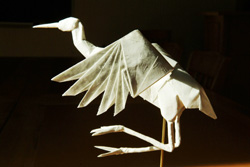Possibilities unfold with origami
The Oscar Peterson Concert Hall resembled craft period on March 2 when the audience ignored the stage and concentrated on folding the sheets of paper they’d been given.
Robert J. Lang, applied physicist, engineer and origami artist was helping the dozens of people who attended his lecture on the science of origami prove one of the mathematical principles that determines and describes the art.
Having seen slides of his intricate and surprisingly realistic constructions of animals, insects and birds, those in attendance were eager to enter the fold.
Lang began his talk with illustrations demonstrating that the Japanese art has existed since the early 18th century. The craft uses folds to create three-dimensional sculptures from a single sheet of paper, with no cuts or glue.
By 1950, there were some 150 origami patterns, the crane being perhaps the most common.
“Around that time origami was discovered by scientists,” Lang said. Theorists began to explore the potential and limits of origami by applying mathematical principles to the art. The number of available patterns leapt from 150 to 30,000 over the next 50 years.
Initially, mathematicians simply applied their own rigorous principles (is it possible, is it measurable and can a recipe be developed for it?) to the practice. Geometric puzzles, like trisecting an angle, that had stumped mathematicians for years became solvable by playing with the combinations and relationships of lines (creases) and points (intersections).
As the laws of origami were identified, it became possible to develop increasingly complex patterns. Mathematics had already determined ways to fold a plane into a repetitive pattern.
Lang demonstrated how patterns could appear as scales on familiar origami constructions like fish. However, he cautioned that the example he displayed incorporated a total of 400 scales and took eight hours of folding to create.
Lang began to break down the steps involved in going from the conception of a shape to its execution. The first step involved reducing a shape, no matter how complex, into a stick-figure which identifies the number of protusions (flaps) involved. Once that base shape is created, refining it is simple.
Lang developed Treemaker, a computer program that extrapolates crease patterns for any conceivable base. Lang’s slides illustrated examples of multi-horned creatures, spiny shells and insects with delicately shaped antennae that he developed from computer-generated patterns.
“When mathematicians began to pursue their own interests for purely aesthetic reasons, no one was aware of the practical applications,” said Lang. But the ability to unfold compact forms has enormous potential. “Origami is the solution to technological problems in the automotive, medical, space and communications industries.”
Lang was approached by NASA to develop a telescopic lens 100 metres wide which “could be used in space to identify distant planets, or be directed back to earth for government purposes that you don’t talk about,” he joked.
Getting something the size of a football field into space was the challenge. Lang developed a way to fold the pieces of such a structure into a three-metre cylinder which would fit in a space shuttle.
Similarly, origami principles can describe the way an airbag unfolds in terms a computer can understand, so that it can run realistic simulations of crash scenarios.
Lang’s visit was co-sponsored by the Science College and the Sigma Xi Research Society. For a gallery of his work, go to langorigami.com, where a free version of Treemaker is available.

